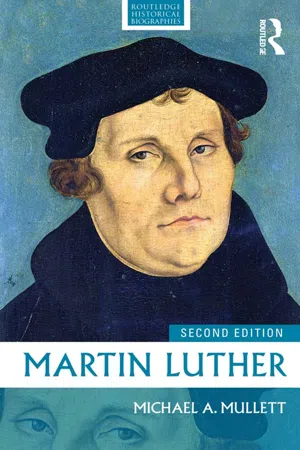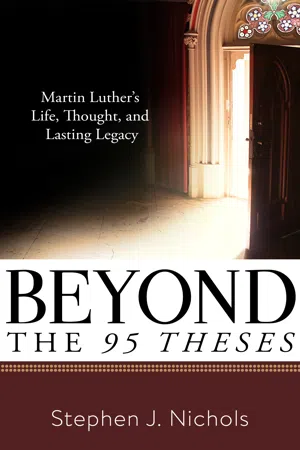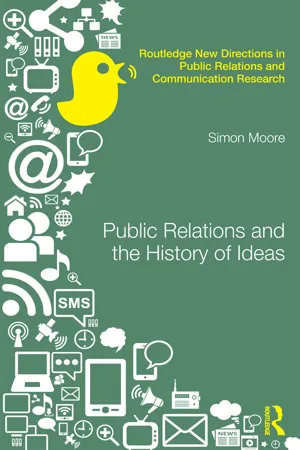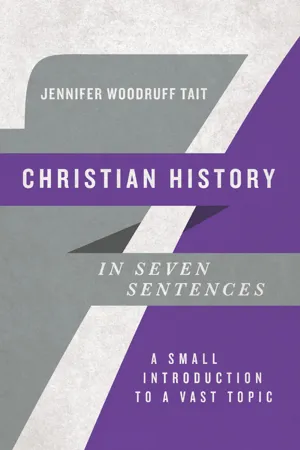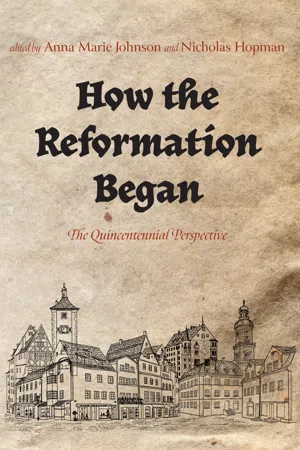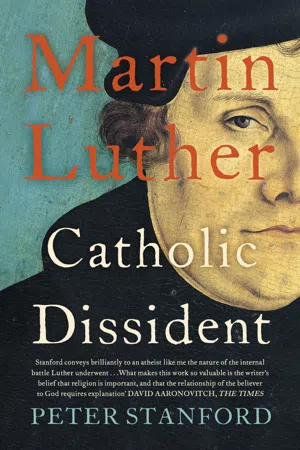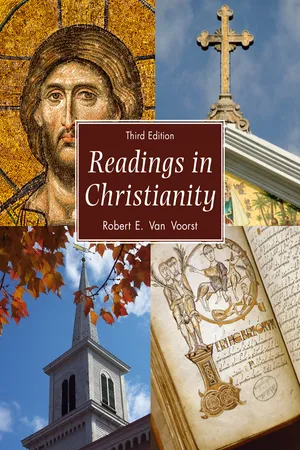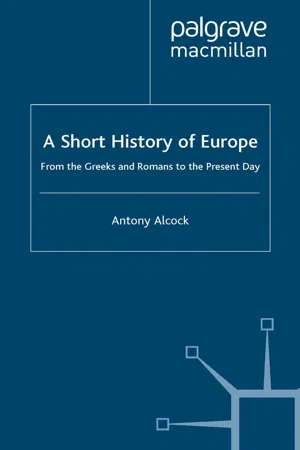History
95 Theses
The "95 Theses" were a set of propositions written by Martin Luther in 1517, challenging the Catholic Church's practices, particularly the sale of indulgences. Luther's act of nailing the theses to the door of the Castle Church in Wittenberg is considered a key event in the Protestant Reformation. The document sparked widespread debate and ultimately led to a schism within Christianity.
Written by Perlego with AI-assistance
Related key terms
1 of 5
8 Key excerpts on "95 Theses"
- eBook - ePub
- Michael A. Mullett(Author)
- 2014(Publication Date)
- Routledge(Publisher)
4 From the 95 Theses to the Leipzig disputation, 1517–19 The sequel to the 95 ThesesThe 95 Theses of 1517 were to springboard Martin Luther into a world of controversy and extreme peril over the next three years, leading to his excommunication by the papacy in 1520 and his criminalisation in the Holy Roman Empire by the Diet of Worms in 1521. These were also the critical years in which Luther’s role altered irretrievably from that of a would-be reformer of the Catholic Church to a declared foe of that institution, as it refused to heed his call to bring its beliefs and practice into line with the doctrines he had been uncovering in his lectures on the Psalms and the Epistle to the Romans.In 1517, however, Luther was not yet the fully-fledged reformer of later years, and the 95 Theses did not arise out of the doctrine of passive justification by faith alone as it was subsequently to be consolidated. Luther was now fully aware that forgiveness came via ‘the grace of God and the piety of the cross’. At the same time, however, there was emphasis in the Theses on the responsibility of the individual to take charge of his or her being forgiven as well as stress on the sinner’s struggle to be contrite. As we saw in the previous chapter, although by as early as 1516 Luther had assembled the basic intellectual presuppositions for the doctrine of justification by faith, within the 95 Theses themselves, as a ‘pastoral’ document, there remained a focus on the sinner’s repentance as an ingredient in his or her being pardoned, an echo of the later medieval concept of quod in se est, the formula according to which God responded to the individual’s efforts to be contrite that we considered in Chapter 2 - eBook - ePub
Beyond the Ninety-Five Theses
Martin Luther's Life, Thought, and Lasting Legacy
- Stephen J. Nichols(Author)
- 2016(Publication Date)
- P Publishing(Publisher)
By confronting the medieval Roman Catholic Church, he was challenging one of the largest political and ecclesiastical machines the world has ever seen. His action on that last day in October set the stage for a century of upheaval in Germany and across Europe. In fact, repercussions of Luther’s actions still ring out today. All who call themselves Protestants trace their roots to this protest in the Ninety-Five Theses. Martin Luther intended that these arguments, written in Latin, be directed toward church scholars for debate. He prefaced his arguments with a request that “those who cannot be present to debate orally with us will do so by letter.” That debate never materialized. The arguments, entitled Disputation on the Power and Efficacy of Indulgences and known popularly as the Ninety-Five Theses, were translated into German, printed (the printing press had been developed relatively recently), and rapidly circulated throughout the cities and villages of Germany. This was only the beginning: by posting the Ninety-Five Theses, the young Augustinian monk set in motion one of the most significant events of western history, the Protestant Reformation. The Ninety-Five Theses is a text that everyone knows of, most refer to, but few actually read. Such a crucial text, though, deserves to be read widely. Today’s readers might be surprised that the arguments lack the crystallized expression of the later Reformation doctrines, such as justification by faith alone. Also, Luther assumes his readers are aware of medieval theology, as well as events of the first two decades of the sixteenth century. Consequently, this edition offers explanatory notes to help readers navigate the text. To set the Ninety-Five Theses in its historical context, we begin with a brief look at the life of Martin Luther and the events in and around 1517. 13.1 Wittenberg on the Elbe River (1546) - eBook - ePub
- Simon Moore(Author)
- 2014(Publication Date)
- Routledge(Publisher)
5 PR and the subjugation of reasonMartin Luther (1483–1546), The Ninety-five Theses (1517)Harnessing mass emotion
We have arrived at a much less subtle and very public work, arguably written for a much less subtle time, but by a mind as powerful as those in the earlier chapters. Even in the Internet era, we are astonished by the speed of the revolution in European belief, politics, art, music, science and philosophy, the horrors of war and persecution, and the massive eventual reaction, all precipitated or intensified by the thunderclap of Martin Luther’s Ninety-five Theses .Europe, and subsequently much of the world, was recast by this mighty act of communication, and, examined as an artefact made for public communication, it seems very modern. The tone, the media it exploited and the content are a violent break from the methodical structures we have already examined. Here is no civilized conversation, courteous questioning or intricate triumph of logic. This is a closely argued outburst of righteous indignation, not aimed at the general nature of government but at a single issue: religious corruption in the Roman Catholic Church, epitomized by the sale of Indulgences guaranteeing less penance in the hereafter.Ninety-five Theses is firstly about the demolition of clerical abuses, and only afterwards about a positive alternative, albeit one that threatened the Church which Luther the Augustinian friar and university professor at first wished only to reform. Consider too the assertions thrown out by this document, arranged like Biblical verses. This is “shock” public communication, a stronger variant of the declarative style followed by al-Farabi, or later echoed by Wittgenstein. We may also claim that this document comes closer to modern PR, not just from its tone, but because it is very effectively competing with alternative messages and media that formerly were hard to contradict. Lengthy justifications, or courteous justifications after the manner of Confucius or Plato are not in evidence here. In the Theses - eBook - ePub
Christian History in Seven Sentences
A Small Introduction to a Vast Topic
- Jennifer Woodruff Tait(Author)
- 2021(Publication Date)
- IVP Academic(Publisher)
- five -MARTIN LUTHER’S NINETY-FIVE THESES (1517)“When our Lord and Master Jesus Christ said, ‘Repent,’ he willed the entire life of believers to be one of repentance.”W ith this sentence, a young Augustinian monk began proposing a set of theses for academic debate by his ecclesiastical superiors. He was worried about the abuse of money by leaders in the church. Especially, he wanted to protest the recent sales campaign of Johannes Tetzel, a Dominican friar who was raising money for the Fugger bank and the local archbishop, Albert of Brandenburg, by selling indulgences—money that would ultimately make its way back to Pope Leo X for the building of Saint Peter’s Basilica in Rome. Surely, if the people in charge knew, he thought, they would do something.They did something—but it was not exactly the something that the thirty-three-year-old Luther wanted.Luther was not the first to call for reform in the way the medieval Western church was preaching, teaching, and living out the gospel. Cries for such reform had echoed down previous centuries, as we’ve read, and many in the early sixteenth century already wanted change. In Basel, humanist author Desiderius Erasmus (1466–1536) had just published a controversial Greek New Testament; in Glarus, priest Huldrych Zwingli (1484–1531) was reading it. But for better or worse, Luther’s Ninety-Five Theses, meant for an academic debating hall, were what set off the thunderstorm that reshaped Western Christianity.1WHERE WE ALL STARTED?
Some years ago, when I was in graduate school at Duke University, I was going over the course schedule with my mother on the phone and happened to mention that Duke offered a class on Luther. “Oh, you should take that one,” she said. “That’s where we all started.” By we she meant Protestant we - eBook - ePub
How the Reformation Began
The Quincentennial Perspective
- Anna Marie Johnson, Nicholas Hopman, Anna Marie Johnson, Nicholas Hopman(Authors)
- 2022(Publication Date)
- Pickwick Publications(Publisher)
1The 95 Theses ( 1517 )
Timothy J. WengertThe year 2017 is the year to talk about the 95 Theses or, rather, talk around them, despite this author’s translation and commentary. The usual suspects for such wandering around Luther’s brief sentences are convinced that they have found either the first movement toward individual freedom by consciences bound in the twilight of the dark ages, or the clarion, religious call to reject all things Roman, or an invitation to be nice to our neighbors, whatever they may believe (the fallback position of American civil religion). Instead, lectures on the Theses should try to convince people to put them in their proper historical context rather than using them as an excuse to worship ourselves and our enlightened times.The history of the 9 5 Theses and their medieval context may be found in other sources.1 This essay concentrates instead on something of a conundrum, namely, why does Luther quote so little from the Bible? For someone, whom later generations wedded to the slogan sola Scriptura , this may seem rather odd. To be sure, these are theses, which Luther was then to prove using scripture passages, so that, indeed, there are many more references to scripture in Luther’s defense, the so-called Explanations of the 95 Theses , printed in August 1518 .2 But such a facile explanation does little to solve the riddle. The few important places where Luther directly deals with scripture come at the beginning and end of the document—a clue that will help us unravel how Luther is using scripture here.Preliminary RemarksBefore going any further, however, readers need to be disabused of the centrality of sola Scriptura as a slogan describing Wittenberg’s theology then or now. Philip Melanchthon never used the term, and Luther employed it in his Latin writings only twenty times (as opposed to 1200 for sola fide and 120 for sola gratia and 500 times for solus Christus ).3 Now, to be sure, he does use the phrase solo Verbo [by God’s Word alone] on occasion, but there it is often hard to know whether Luther is talking about the preached word, the written Word, or both. In any case, as Scott Hendrix proved in his book on Luther and the papacy, Luther never abandoned other authorities besides scripture, so that the church fathers, the decrees of the councils and, above all, the catholic creeds also were authoritative for him throughout his life—as they should be for later Lutherans.4 Peter Fraenkel, the Melanchthon scholar, writing in the 1960 s, found a far better Latin phrase in Melanchthon’s writings—one that could more accurately replace sola Scriptura in stained-glass windows.5 For Luther and his colleagues, scripture was the primum et verum - eBook - ePub
Martin Luther
Catholic Dissident
- Peter Stanford(Author)
- 2017(Publication Date)
- Hodder Faith(Publisher)
The Ninety-Five ThesesIs that ‘someone [who] may rise’ Luther himself? That is the implication of a postscript he adds, noting that he has attached his ‘disputation theses so that you can see how dubious is this belief concerning indulgences, which these preachers propagate as if it were the surest thing in the whole world’. Why send the Ninety-Five Theses unless he is signalling his own willingness to lead the attack on the indulgence system? Indeed the format – as a set of propositions to be discussed and disputed in the manner beloved of Scholasticism – makes it plain that Luther is offering to present the case for the prosecution. Their inclusion signals a threat that is hardly downgraded when he signs off as ‘your unworthy son’.27It is not known how carefully Albrecht studied the attachment, if at all, but even if he left that task to his officials, they could have been in no doubt that Luther had the potential to cause a little local difficulty. The Ninety-Five Theses begin with an announcement that, ‘out of love and zeal for truth’, what follows will be debated at Wittenberg under his chairmanship. He requests that those ‘who cannot be present to debate orally with us will do so by letter’. He is spreading his net wide.One of the earliest printed versions of the Ninety-Five Theses: from a display at the Lutherhaus in Wittenberg. The first four theses offer an overview of Luther’s own still-emerging views on sinfulness, forgiveness and salvation. 1. ‘When our Lord and Master Jesus Christ said, ‘‘repent’’, He willed the entire life of believers to be one of repentance.’‘Theses’ has the ring to modern ears of one thesis after another, one idea followed by something linked but separate. Instead the ninety-five are more a series of breathless bullet points, which ebb and flow between different aspects of the question, and between outright condemnation and efforts at mitigation and seeing the other side. The effect of reading them as a list can be slightly dizzying. This is no carefully structured argument; there are no sections on specific issues, nor even a framework to guide a fuller debate. Later Luther was to write much longer documents seeking to explain what exactly it was he meant by the wording he had used in some of the ninety-five. He knew, on reflection, that in places he had provided little more than a set of headlines. - eBook - PDF
- Robert Van Voorst(Author)
- 2014(Publication Date)
- Cengage Learning EMEA(Publisher)
Events: Luther’s Protest Against Indulgences 173 Luther’s Protest Against Indulgences* Luther proposed these theses , or points for debate, on October 31, 1517, traditionally regarded as the beginning of the Reformation. He also sent a copy of his theses, with a cover letter, to Prince Albert of Mainz. Luther objected to the selling of indulgences and related doctrines and practices of the church. (Unknown to Luther, Albert was using funds from indulgences to repay a loan he had taken out to pay the pope for his appointment as archbishop of Mainz.) The theses were quickly published and widely circulated in Germany and beyond. They contain the basis for Luther’s later view of Christianity: for-giveness comes from the free grace of God based on the death of Jesus; salvation is gained by faith, not by religious deeds; the gospel must rule the church. Out of a love and zeal for the truth and the desire to bring it to light, the following theses will be publicly discussed at Wittenberg under the direction of the Reverend Father Martin Luther, Master of Arts in Sacred Theology and regularly appointed Lecturer on these subjects at that place. He requests that those who cannot be present to debate orally with us do so by letter. 8 In the name of Our Lord Jesus Christ, amen. 1. When our Lord and Master Jesus Christ said, “Repent,” 9 he wanted the entire life of believers to be one of repentance. 2. Repent-ance cannot be understood as referring to the sacrament of penance, that is, confession and satisfaction as administered by the clergy. 3. Yet it does not mean solely inner repentance; such inner repentance is worthless unless it produces various outward mortifications of the flesh. 10 *From Henry Wace and C. A. Buchheim, Martin Luther’s First Principles of the Reformation, or the Ninety-Five Theses and the Three Primary Works of Dr. Martin Luther (London: John Murary, 1883), pp. 2–16. - eBook - PDF
A Short History of Europe
From the Greeks and Romans to the Present Day
- A. Alcock(Author)
- 2002(Publication Date)
- Palgrave Macmillan(Publisher)
9 Reformation, Counter Reformation and Religious War 1500±1650ad By the middle of the fifteenth century Germany was seething with dissatisfaction with the Church. Because of the weakness of German central political power the Papacy had a much stronger position than in England, France and Spain where the Church was much more `national'. Thus the Papacy was still able to appoint French and Italians to German bishoprics and, since less money was com- ing from the countries with `national' churches, it was demanding increased contributions from Germany. A second source of resentment was the behaviour of the senior clergy, who considered their bishoprics as feudal fiefs and a means of maintaining standards of living commensurate with their social status rather than paying attention to their spiritual functions. These were left to the parish clergy, who were in many cases theologically ignorant or illiterate, and poorly paid. 1 Third, at a time of intensification rather than decline in religious belief, there was resentment at the deterioration of ecclesiastical means of salvation into substitutes such as confessions and the sale of indulgences. Martin Luther, a Saxon (1483±46) had studied law at Leipzig University, joined the Augustinian Order of Hermits in 1505 and was ordained in 1507. His Order sent him to Wittenberg University to teach moral philosophy, where by 1511 he was a Doctor of Theology and Professor of Biblical Studies. And it was in Wittenberg on 31 October 1517 that Luther posted on the door of the castle church his ninety-five theses attacking the sale of indulgences, the Church's preoccupation with material pos- sessions, and contrasting those material possessions with its true wealth, namely, the Gospel. Crucial to an understanding of Lutheranism and its significance are Luther's interpretation of the relations between God and Man, and, linked to it, his views on politics and society, particularly the place of labour. 124
Index pages curate the most relevant extracts from our library of academic textbooks. They’ve been created using an in-house natural language model (NLM), each adding context and meaning to key research topics.
